Text
Confessions of Professional Rejector
"Can I get a meeting?"
It turns out that when your job is to give away money to companies with no customers and an unfinished product, a lot of people are interested in talking to you.
Being a venture capitalist is weird. Have you ever heard that investors only say yes 1% of the time? Now imagine what it’s like to live through the other 99%.
Founders ask investors for a meeting in their very first interaction. It’s jarring to get cold Twitter DMs with zero preamble or context, a paragraph (or many) about their startup, and then an ask for your time.
"Bryan, we are trying to change the fact that 90% of all [redacted] lose money. When do you have time for a meeting?"
"Wanna help us with intros to Tier 1 funds? We just got a US patent granted and want to start ASAP. Let's jump on Zoom and discuss"
"Bryan, would you be willing to look at my deck for a psychedelic clinic?"
"[5 long paragraphs...] Kindly help me actualise my dream"
When I stepped into a VC role, I learned quickly that there aren’t enough hours in the day to accept every meeting request and still do other necessary work and live life. I had to refine my criteria for who I want to spend time with, and then get ruthless about turning down all other requests to survive.
Some VCs try to do things that better scale, like having an application process, hosting office hours, or appearing on podcasts and panels. Others create more friction by requiring warm intros, never answering emails, and ghosting founders mid-conversation. Saying no is a big part of the job, regardless of how you manage it.
When you look at a no as a rejection, it can feel horrible. It's not easy to ask someone for time or money, especially when it might result in keeping your company alive a bit longer. It's even worse when you don't learn why your request was declined because your mind will make up stories about what might have happened.
I came up with a metaphor that helps me reframe things. I try to look at it more like the way attraction works in nature. Take bees and flowers, for example.
Bees want nectar for energy and pollen for protein. Flowers want bees to land on them, get pollen stuck on them, and then go pollinate other same-trait flowers.
Some bees are only attracted to specific flowers with yellow and purple petals. Pink flowers don't sit around feeling bad that these bees ignore them. They just wait for the bees that are a match for them.
Finding investors, co-founders, and employees is like that. It’s about finding the right relationship at the right time. There are a lot of people and a lot of opportunities out there and they won’t all be the right fit for you. But you still have to get out there and smell the flowers if you expect to make any honey. This metaphor is tired now and needs to go to bed. Sorry it didn’t work out for us to have a meeting.
1 note
·
View note
Text
First Single
On Thursday, my wife and I dropped (as the kids say) the first single off our first album. Releasing a single was part of the plan our PR rep suggested and would’ve have even occurred to us to do. Aren’t singles only for Beyonce and The Weeknd?
We had low expectations for the response - it’s not like a Bulgarian folk song performed by a voice and banjo duo is going suddenly to break into the mainstream charts - but we’ve been blown away and humbled by the reactions. People from my past and present are reaching out to say kind things. High school teachers, college peers, first employers, colleagues, and even a famous Bulgarian actor. It’s a bit thrilling and makes all the hard work that we put into the record feel even more rewarding.
One thing we needed for the single release was a lyric video to post to Youtube. Lyric videos range from simple text on a solid background to animation to full-on productions with the artist on location with makeup, lights, and multiple cameras. I had a few nights to get one together, so opted for keeping it simple. I found some amazing stock drone footage featuring the exact Bulgarian mountains that are the setting for the song (what a wondrous world we live in!), and managed to grind my way through getting it done using Adobe After Effects after failing to get something I liked with iMovie.
We’re really proud of our art and the work we’ve put in to bring it to life and there’s more to come. We have a live concert performance of this first single, 2 more singles, and then the full album release coming soon. It’s all a new experience, so we can’t know what to expect, but we’re having fun now and I’m grateful to share this with anyone out there who cares to listen.
So, here’s our official lyric video for ‘Pesen Za Boiana (Song for Boiana)’, which is an anthemic battle song celebrating a fearless woman rebel leading her 9 brothers into war against the Ottoman Empire. Thank you for being a part of our adventure!
youtube
2 notes
·
View notes
Text
Change
I spoke to Kate Brodock, the CEO of Women 2.0, this week. It's so impressive what they've built - they have a VC fund, an accelerator program, an angel investor training program, a corporate allyship program, and a media platform full of valuable content. I recognized a lot of overlap in the work Kate does and what I did at Backstage Capital, and it was wonderful to see the attention being given to women founders and investors.
I know I'm deeply involved in this world, but I'm sure everyone is seeing lots of initiatives to diversify tech. There are women-only investor groups, Slack communities for BIPOC founders, venture funds focused on underrepresented groups, etc. It's possible to look at organizations like Women 2.0 and Backstage and think, "great. These folks are totally focused on these DEI initiatives and are doing an excellent job. Seems like things are covered!"
But then take a look at the stats and you'll see that only 2% of venture capital dollars last year went to women-only founded companies. That's 2% invested into roughly half of our population. That's f***ed up.
Why should the targets of systemic inequality disproportionately be doing the work? Why do they have to lift themselves up to solve problems they did not create? I think White men need to shoulder much more of this burden. And here's the thing - I don't even need to join a new group or speak out publicly about some injustice, I just need to take action within whatever sphere of power I have.
I invest in founders. I choose to sometimes invest in women. That's it. It's so simple, yet so powerful. If you're hiring, hire a person of color. If you're in any way giving value, offer that value to those who are underestimated. Do this more than 2% of the time. If that's hard to do, then take the time to look at why it's hard. That’s your work to do.
I do hope people speak out about injustice, and I believe we need all of the initiatives out there to work toward an equitable future. But, don't underestimate the impact you can make with your own actions whenever you're in a position of power. Imagine what could change if lots of people took even a little bit of action.
2 notes
·
View notes
Text
What’s Old is New
As I get older, new music often sounds a lot like old music. It's impossible not to hear references to things that came, sometimes decades, before. Sometimes it feels like nothing is truly new. It's the same in fashion - the endless cycles of skinny clothes and baggy clothes marking the birth and death of each trend. Squint at our current culture and it's conceivable we're back in the 80s or 90s.
But, the artists making music today are experiencing it for the first time, as are many of their listeners. And today isn't the same as yesterday. The context has changed. What it means is different. Some new things are possible that weren't before. Fresh perspectives can change the world.
This is true in startup investing, too. I'll see a familiar idea and think, "yeah, but 5 companies tried that and it didn't work." But timing is everything. Maybe the market wasn't ready before. Maybe a technological advance has made something new possible. Maybe the founder didn't have what they needed to pull off the idea.
Google was late to the search party. People buy groceries online every day. Whatever disaster of a startup left a crater in the past, eventually some clever founder finds a way to bring the idea back from the dead to find great success.
I think it's a mistake to discount ideas that feel familiar when they exist in new contexts. We can learn from the past (the idea maze) yet hold a sense of resilient optimism when considering, or reconsidering, ideas.
0 notes
Text
Focus
I have a Notion page titled "Focus" that has all the initiatives I'm working on and the next most important things to do for each initiative. I try to check in with that list every morning to prioritize my time and make sure things aren't getting dropped. My duties currently include fundraising (new for me), deal flow, fund management, working alongside our portfolio founders, as well as managing (and sometimes working on) client projects. I could do any one of these things full-time. I'm used to this, I had a similar variety of functions at Backstage Capital.
Lately though, I've been feeling like I'm not doing anything at the level of quality that I like to operate at. Living in that state of being is exhausting. Sometimes I feel underprepared like I'm not showing up fully to things. I go to bed too late to get the hours of sleep I need but then wake up early to be ready for the day. As the week goes on, I get more tired. That means less strategic and creative thinking and less good decisions, and that's not the space I want to live in.
One thing I'm doing to resolve this is to rework my weekly schedule to better align with my priorities. Mondays and Tuesdays are for fundraising; Wednesdays and Thursdays are for meetings (investors, founders, partners, etc.); and Fridays are for execution. If I don't block out time for important things, my calendar will get filled in with other people's priorities. Also, I tend to do what I already know and am best at, which means that without intervention, I'll avoid doing the harder, but possibly more valuable, things I need to do.
This isn't a new or original tactic, but it's intentional and powerful. I'm curious if you've had success with this or other solutions to juggling multiple priorities. Let me know.
0 notes
Text
Secret Identity
By day I’m a VC at a startup studio. By night I’m a musician gearing up to release my first album, a duo project with my wife and 20-year musical collaborator. Something remarkable happened yesterday. We got a wonderful quote about our upcoming release from someone I deeply respect and who is considered the best in the world at what they do. I was overjoyed. I wanted to celebrate. I realized there were few people in my life whom I could share it with that would truly understand what those words mean to me.
Looking back on my adult life, I sometimes feel like I've had multiple careers. Touring and recording banjoist, film and TV music composer, product designer, venture capitalist. It's a non-linear and disparate path. Very often parts of my identity don't surface in the many interactions I have with people. When enough time goes by without mention of the most active aspects, I start feeling like I'm maintaining secret identities.
Lately, that feeling has been intense because we're putting a lot of energy into our album. We're working with a PR agency, did a photo shoot for the press kit, collaborated with a copywriter for our press release, designed physical CD packages for promotion, and are editing live videos to release before the release date. It can really feel like I have distinct personas with their own goals, vision for the future, and relationships with others.
Somehow though, I feel like when our album is released (on May 21!), I will experience a reintegration. When people ask, "oh, you're a musician, cool. Where can I hear your music?" I'll be able to simply say, "Spotify, Youtube - wherever you listen." And if they go and check it out, they'll learn about this other aspect of my self which I'm proud of. And as we promote the album, I'll likely share more about this other side of my life, stepping into the multi-dimensionality. I'm really excited to experience that!
0 notes
Text
Gen X Y Z
The hype machine for Gen Z is so strong. It feels to me like the brand for my generation, X, was never embraced and slipped by without much fanfare. Gen Y, you know, Millennials, enjoyed their time in the limelight as the first digital natives, free from the shadow of Baby Boomer culture.
But now that Zoomers are adults, they have fully embraced their generational brand, owning it in communities, consulting firms, and social media bios. This brand, based largely around youth, will need to evolve over time because no generation stays young forever. Gen Alpha is aging at the same rate as the rest of us, after all.
Not having grown up with social media (ok, not even the Internet for a bit), and being someone not naturally inclined to public sharing, I really find myself grappling with emotions around an increasingly outwardly-centric culture. It seems like everyone has a personal brand, is a thought leader or influencer, tweets many times daily, and fluidly adapts to new networks like TikTok and Clubhouse. And the opportunities that flow to those rewarded for sharing can be real and valuable. Funds are raised, jobs are landed, and attention compounds.
Sometimes the more I see others share, the more alone and self-critical I feel. I’m not gaining 10k followers. I’m not launching a viral community. I’m not building in public enough. What could there be of value to say amidst this endless torrent of information and human expression? So, I go quiet.
I’ve developed ways of coping with these dark mental loops, but it’s an ongoing struggle. That’s why I’m writing this now. To share and be vulnerable. To show up authentically for myself. To be curious enough about new cultural trends, new channels for communication, and new generations to see what’s on the other side.
0 notes
Text
Pitching vs. Shipping
Here's something odd for me to say as an investor: I don't really like pitches. It's odd because a huge part of an investor's job is to field pitches from founders. Lots and lots of pitches. If a founder finds out you're an investor, they're going to shoot their shot. At in-person events (remember those?), demo days, by email, LinkedIn, Twitter DMs...
Here's what usually happens when founders go into pitch mode: they stop acting like normal humans. Their eyes lose focus and they start speaking very fast, likely imagining the 1-3min countdown clock most public pitch events enforce. The conversation becomes a 1-way exchange, bound to a pre-scripted narrative that may or may not resemble reality.
As an investor, it puts me in a position to immediately be judging the founder, their communication quality, and the business. It puts us immediately in a negotiation, even if we've never met and don't know anything about each other. That sucks for me because I'm best at being supportive and collaborative.
Pitches now have TV shows, podcasts, and, most recently, so. many. freaking. Clubhouse rooms.
I won't deny that storytelling and manufactured FOMO can have a definitive impact on the psychology of investors - we're all human after all. But, there's a danger in over-focusing on the pitch at the expense of actually doing the work. Shipping new features, learning from customers, and doing the things that move a business forward might make a pitch superfluous. If there's amazing traction, great founders, and a big market, investors will be interested.
So, what do I like instead of pitches? I like clear, honest, 2-way conversations. I like succinct one-page memos. I like constructive office hours, jam sessions, and walk-and-talks. For even a brief moment, I want to be on the founder's side, trying to contribute value and encouragement. I hope founders can spend as little time as possible fundraising, and as much as possible on the most important actions they can take toward success.
0 notes
Text
Sharing Drafts
Ok, so I’m picking up my Tumblr account after years of sharing on Medium, Twitter, and elsewhere. I wanted a place to experiment, and I think this is as good a place as any. Thanks to Matt Mullenweg for saving this wild home for weird content.
Here’s what I’m up to. Everywhere else in my life, I like to pride myself on creating things of a high quality. Investing, design, content marketing (blogs, podcasts), etc. Often I’m the one on the team editing everyone else’s content behind the scenes. But the price you pay for being an editor is that sometimes your own raw creative output gets stifled.
I was challenged by my coach to create a shitty blog. A place where I share something on mind and play with vulnerability, but then not worry about how shitty it is before hitting publish. Of course being the designer I am, I started concepting how to brand it using the 💩 emoji. But, how about this - I won’t even give it a name. These are just unpolished drafts.
I’m going to do this weekly, giving myself an hour max to write something. Considering how long it normally takes me to write a blog post, or even a tweet sometimes, I’m certain I’m going to be uncomfortable.
It’s an experiment. I have no idea what’s going to happen. Here goes...
0 notes
Text
Google Script for Migrating Otherinbox Defender Email Addresses in Gmail
tl;dr Scroll to the bottom for instructions on using a Google Script you can use in Google Docs spreadsheets to extract your [email protected] email addresses you'll need to migrate before Otherinbox officially sunsets "Defender".
Hook
Otherinbox first launched as a service that let you choose a username which was prepended to a subdomain that you could use to form email addresses on-the-fly. My subdomain was bryan.oib.com ('oib' was the shortened domain for "Otherinbox"), so when required to supply an email at checkout at an online store, I would give "[email protected]". This was endlessly entertaining to do in-person; salespeople would hear their company's name in my email address and say, "no, we need your email." I got quite good at pitching the concept. Often the salesperson would relent and accept the funky email and say, "huh, that's really cool."
Line
The value of dynamically doling out unique emails was that you didn't have to reveal your real email to the recipient, and, in the event the recipient sold your email to spammers or decided to include you in noisy email campaigns that neglected to provide an unsubscribe mechanism, you could ban that specific email address. I also found them very handy for my beta junky habit of trying every new web app that looks interesting.
Sinker
But a clever idea does not a business make, so after initial growth proved too slow, Otherinbox pivoted to pursue other features in the email space. They were very generous, however, and only slowly phased out what they called the "Defender" product I was hooked on. First the UI for replying from custom emails was pulled. Then there was an awkward switch to using Google Apps for email routing. Somehow though, none of it encouraged me to abandon my on-the-fly email creation habit, and it was only in late June, 2014, nearly 6 years later, that the email finally came announcing that "Defender" would be kaput by the end of the year.
I set to searching my gmail archive for emails sent "to:bryan.oib.com" to compile a list of addresses I'd need to migrate. Once I got a few pages in ("500 of Many"...seriously?) with 30 addresses extracted and was only viewing emails from a few months previous (remember, I have over 5 years of making these things up!), I knew some geekery was in order to make this feasible.
Catch
This was my first time using Google Scripts, and the experience is a bit awkward, so hopefully this little post will help someone in a similar situation. The script below will give you a single-column of results where each row will be a unique email address matching the search you enter into the prompt.
Create a new spreadsheet in Google Docs and click on the first cell in row 1, column A.
Click on the 'Tools' menu and choose 'Script editor...'
In the modal window, under 'Create script for', select 'Spreadsheet'.
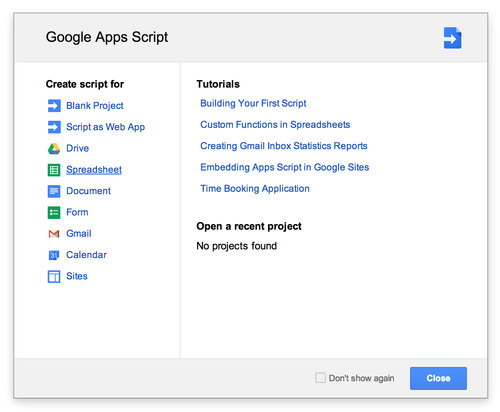
Paste the code from this gist into the new script file.
Save the script and give the Script project a name of your choosing.
Choose 'writeEmailsToCurrentSheet' from the "Select function" menu.

Click the play button to run the script.
You'll need to give the script authorization to access your Gmail account. Click "Continue" from the modal, then "Accept" from the popup window.

Go back to your spreadsheet, and you'll se a prompt where you can type in your Otherinbox email's domain (the part after the @). I searched for "bryan.oib.com" to extract my Defender addresses, for example.

Click "Ok" and give the script some time to run. In a minute or so, you should see your spreadsheet populated with a list of unique emails matching the search you entered. Now you've got a list of emails you'll need to migrate!
Release
I have 96 Defender addresses I'll need to migrate. I'm pretty glad I didn't manually go through all those years of emails to find these and I hope this tutorial saves you some time, too ;)
Thanks to Otherinbox for all the years of service and I wish the company and team the best of luck in making email better. Cheers!
0 notes
Text
Seeking Aha!

The Emotion Required for Product Growth
The “aha! moment”, a term I first heard mentioned in relation to startup product design by Qualaroo CEO, and the original growth hacker, Sean Ellis, defines the moment when a customer truly experiences the value of a product during actual usage. The time and effort needed to achieve this moment differs greatly from product to product. Ellis relates the challenge of getting users to “aha!” with LogMeIn, a product where users had to install software on their work computer, find themselves in a situation where they needed to remotely access that computer, and finally remotely login from a different computer and take care of whatever task justified all of that effort. Ouch.
At the moment of “aha!” we experience a strong emotion. It might be the relief of pain caused by something formerly tedious or difficult. It might be the thrill of being recognized as a tastemaker or authority on a particular topic. It might be feeling prepared for your job or not being embarrassed by forgetting something important to a friend, colleague or employer. The emotion experienced in that moment of product value realization is as varied as there are products to use, but at least one always exists.
A Perfectly Orchestrated “Aha!”
Gentry Underwood, Mailbox CEO and former-IDEO, tells the story behind the brilliantly executed promo video with which Mailbox launched. Their optimal goal would be to grow a waiting list before the product was even ready for launch. They decided that a short and heavily shared promotional video was the appropriate vehicle for their message. The Mailbox team looked at what commonalities there were amongst viral videos for clues, and what they found was that they all evoked a strong emotion. It didn’t matter what emotion (shock, happiness…), but just that you felt one upon watching the video. They decided the ideal emotion for a product video was desire. Giving people a juicy, tantalizing taste of what it felt like to use the app’s most remarkable features, in all their delightfully post-PC, swipe-riffic glory, would result in the desired effect: “I want that.”
In terms of inducing an “aha!” moment, what the Mailbox team did was extraordinary. They shrank the usually long and burdensome path from product discovery to value realization down to 1 minute and 11 seconds without even requiring the customer to actually use the product. Few marketing efforts yield such stunning rewards (more than 800,000 people queued up waiting to use the product), but the lesson to be learned is to focus on the emotion you need to inspire to achieve your goals and work backwards from there.
How to Find Emotion
If you’re still developing your product, your mission is to hone in on an emotion strong enough to compel someone to repeatedly use what you make. You should deploy a number of differing experiments to find the most compelling emotion and product fit. There’s never a better time to try risky, quirky ideas to gauge an emotional reaction than before you have paying customers and a brand and quality commitment to uphold. What unexpected feature might result in triple the engagement? What effect does involving a secondary audience have on your key metrics?
If you already have a product, you can make use of the product/market fit survey popularized by Survey.io, which will surface people who would be “very disappointed” if they could no longer use your product. These customers have reached “aha!” and have experienced a positive emotion strong enough to repeatedly engage with your product. Interview them and listen to how they describe these feelings in their own words and how they arrived at that moment. If your product includes “must have” features, then your job is to figure out how to get more people to experience that emotion. If most of your customers aren’t experiencing a strong, positive emotion yet, you’ll need to keep iterating on your core product if you intend to grow.
“Aha!” + emotion-centric resources: http://www.nirandfar.com/ http://www.bjfogg.com/ http://www.startup-marketing.com/
0 notes
Text
Form Design: Text Field Specimens
Forms are everywhere. They're how we humans share information with computers and are baked into the essence of web products. There’s the form you type in to search for something on Google, the form where you type your tweets on Twitter, the form where you enter your credit card information to buy something on Amazon.
BJ Fogg’s Behavior Model applies to forms - you need to want the offered reward enough to trade personal information or ideas plus the time and effort needed to fill out and submit a form. If the form is hard to complete (poor UX, too many fields...) and your motivation is low (the reward isn’t enticing enough), you will abandon it. But, a form’s design can encourage you to use it. The best designed forms make you want to complete them.
I recreationally went through 50 pages of search results on Dribbble for “forms” and made a bucket of my favorite modern text input field design. Below are examples of patterns that emerged. You can see the sources here on Dribbble.
Bordered on Same-Color Background
I'm a fan of minimalism. The simplest design for a text field is a simple bordered input field where the input background matches the form background. There's plenty of room for character and vibe using color, border thickness, icons, labels, and placeholder text.
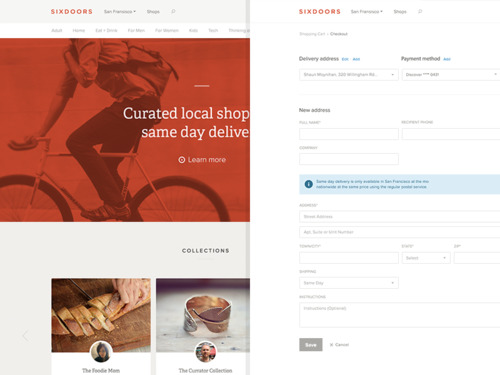



Light Gray on White
Another minimalist approach is to forego borders (or reserve them for focus states) and use a light gray field background with just enough contrast to stand out on a white form background.

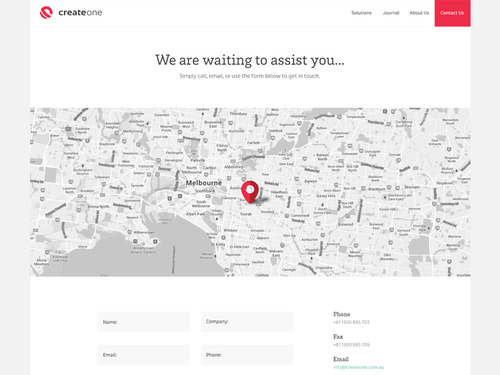
White on Darker Background
A white text field set on a darker background feels safe and traditional. A modern spin is to skip the border, giving a flat look. You get bonus hipster points if you float it atop a trendy, photographic background.
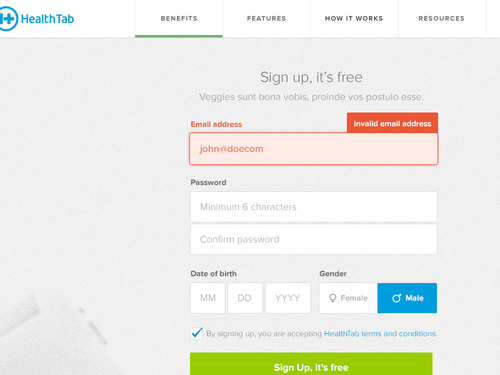
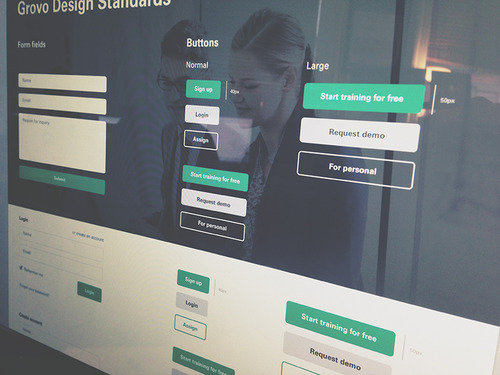
Dark on Dark
One pattern that can still look exciting and very well-suited for the mobile world is a dark form background color with text field backgrounds of the same shade, but lighter or darker to create enough contrast to be discernible as an input field. There's something mysterious about it, yet done well, it can be perfectly usable.
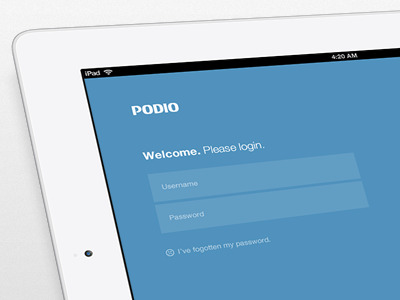
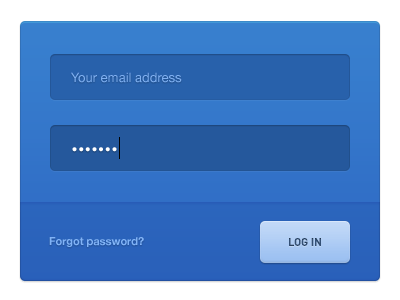
Skeuomorphic
I'm not generally a fan of skeuomorphism, but I have a soft spot for forms that mimic real world objects. Fill-in-the-blank-style inputs can make you feel like a kid filling out Mad Libs, like you're writing a physical letter, or like you're filling out a name tag. There's something charming about the experience and the usability is excellent because it leverages known behaviors taught to us as early as kindergarten.
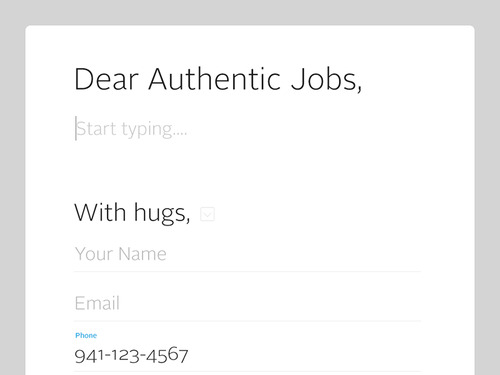

Underlined
Taking the simple bordered text field even further is the single bottom border look. Having no contrasting background color or border creates two UX issues with this pattern: they might not be recognized as form fields and labels are either difficult to position well or require using placeholders for labels, which will disappear once any text is typed. For very well-known forms (login, sign up...), this pattern can work and be interesting.
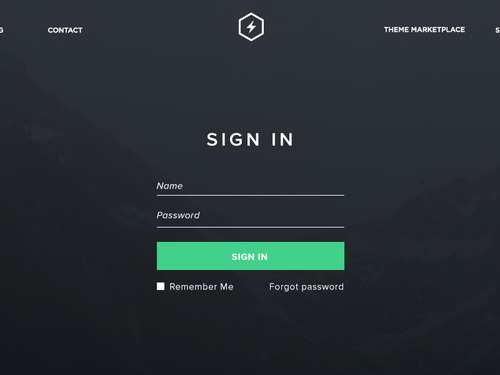

Structural (wtf?)
The last pattern I was intrigued by, but am not yet sold on, is one I'm not sure how to classify. In this pattern, the form fields have no margins between them, forming a grid layout similar to those you see on paper DMV or rental forms. They are more compact than other form designs, so they will work best in modals or on phones, but they make labels awkward and sacrifice usability for information density.
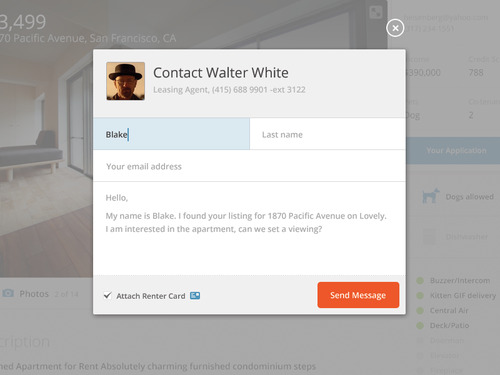
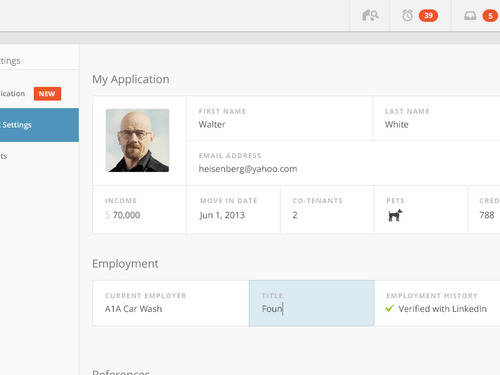
See larger versions of the above forms here on Dribbble.
0 notes
Text
Most Advice Is Useless
Why I’ve stopped reading most content about entrepreneurship

Bloggers are obsessed with giving advice. “10 things you should…”, “What I learned by…” Some advice is anecdotal; some is data-driven. The trend is generally well-intentioned, or at least mutually beneficial. Authors try to offer value with their content marketing in hopes to gain attention in exchange for educational information.
The problem is:
90% of the advice I read is not actionable to me now.
I am a solo entrepreneur seeking a co-founder and exploring startup ideas while bootstrapping with consulting work. I used to swim in the sea of useless advice looking for motivation, inspiration, and practical knowledge. A new fatigue set in, as if my tolerance for unnecessary information had eroded beyond some indeterminate breaking point. While I will doubtless be reeled in by the occasional link bait, I am aware that the purpose of consuming such content will be entertainment.
Useless Topics To Me Right Now
Fundraising To quote Paul Graham in his glorious succinctness: “don’t raise money unless you want it and it wants you.” I have a mountain of things to learn about fundraising, but the information and advice will be there when I need it. It’s more important to focus on doing things that will make money want me.
Culture There is no culture of one. I don’t lack ideas on how to inspire and shape culture, I just can’t make use of them right now. I find profiles on remarkable cultures (Github, Valve, 37signals…) intriguing more as human behavioral case studies than as actionable input.
Scaling Scaling a company, tech infrastructure (servers, databases…), advertising, user growth, or experiences offered by a product are not relevant to me right now. “Do things that don’t scale,” is another Paul Graham refrain that encourages founders to find out if anyone cares about what you’re making before proceeding any further. If no one wants what you’re offering, no elegant code or beautiful design will keep your startup alive.
Hiring & Recruiting People are obsessed with concepts around growing a team — interview questions, recruiting tactics, negotiation strategy... I need to learn how to recruit just one collaborator. I need to achieve traction on an idea. These are hard problems; I don’t have the time or desire to dwell on problems I don’t have.
There’s still an ocean of advice that is useful to me now. The entrepreneurship topics I find most useful at the moment are focused on uncovering problems to solve, testing prototypes, and stories about the early days of successful startups.
How much time do you spend consuming content you can’t make use of?
1 note
·
View note
Text
Look Beyond The Medium
Photo Sharing Is Message Sharing

Recently I found myself thinking, “I can’t believe I’m exploring ideas that could be considered ‘photo sharing’ app territory.” The way I arrived there was circuitous, so the observation snuck up on me.
This simple fact freed me from worrying about it:
Photos are a communication medium.

Twitter began as a text-only medium, but has grown to accommodate images and video.
The base media humans have most utilized in order to communicate are: text, images, and sound. It should not be a surprise that image-centric apps have found success online. Substitute “text” for “photo” when you hear someone bemoan, “do we really need another photo sharing app?” Enjoy their amusing befuddlement.

Tumblr has always been multimedia-centric; it features format options for popular use cases.
Location is not a medium. Social networks are not a medium. Cats are not a medium.
Sequenced images, sometimes accompanied by sound, offer a different enough experience that video is considered a medium. Animated gifs live somewhere between still and moving images, yet they have evolved culturally into their own medium.
Out of physical and technical limitations grow new media that marry a device or delivery mechanism to a communication format: soft-cover books and novels; large-screen projectors and movies; the television and shows; magazines and articles; SMS messages and tweets.
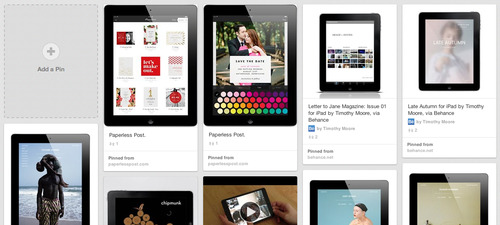
In Pinterest, pins are images or videos, but there is much more being communicated than the medium implies (aspirations, desires, tasks…)
Don’t mistake features for media. Don’t dismiss an entire medium. Your favorite medium is not everyone’s favorite.

Instagram elegantly showed that images can allow communication even across language divides.
We will always be exploring new and compelling ways of communicating with media. As we are limited by the human sensory system, finding new media likely will be focused on combining already popular base media (although, touch and smell are still quite under-explored senses in the digital age.)

Through impermanence, Snapchat encourages using photos directly as messages — a perfect example of images as a communication medium.
The next time you hear about a new photo sharing app, look beyond the medium and assess the features, product design, and experience it offers instead.
Cross-posted to Medium.
1 note
·
View note
Text
Apple's New iPhone Marketing Language


At least the colorful iPhone 5c phones are fun and playful, even if their introduction lacks those qualities. I look forward to the commercials for those.
0 notes
Video
youtube
Here, a young Jimmy Page shares that he wanted to be a cancer research biologist when he grew up. He was one my first guitar heroes that inspired me to play music. I'm glad he didn't realize those particular early dreams. For some reason this video makes me recall this exchange from Harry Potter: "Did you know--then?" asked Harry. "Did I know that I had just met the most dangerous Dark wizard of all time?" said Dumbledore. "No, I had no idea that he was to grow up to be what he is. However, I was certainly intrigued by him."
0 notes
Photo

Check out this amazing HTML email from Airbnb. It's incredibly compelling because it manages to tell a story without any real details, which lets you fill in the blanks with your own imagination. The design creates a momentum that all leads toward one singular outcome: you clicking the "enter" button.
1 note
·
View note